





elcome to DAWN, our comprehensive series for Early Childhood Education that has been meticulously crafted to align with the guidelines of the Foundational Stage as outlined in the National Education Policy (NEP) 2020. This series is designed to provide a holistic learning experience, fostering the comprehensive development of young learners in accordance with the developmental milestones and learning outcomes specified in the National Curriculum Framework (NCF) 2022.
DAWN offers a rich blend of interactive and activity-based content to nurture each child's physical, emotional, intellectual, and spiritual growth. Our approach ensures that learning is enjoyable and meaningful, catering to every child's interests and abilities. By integrating various domains of development, we aim to create an environment where children can thrive, explore their unique potentials and cultivate a lifelong love for learning. The curriculum is structured to promote Physical Development by incorporating activities that enhance motor skills, health, and overall physical well-being. Social and Emotional Learning (SEL) is a critical component focusing on building empathy, cooperation, and strong interpersonal relationships. Through engaging and thought-provoking activities, children develop Intellectual Capacities, fostering critical thinking, problemsolving, and a curious mind.
In line with the NCF 2022, DAWN also emphasises Spiritual and Moral Development, encouraging children to understand and embody values such as honesty, integrity, and respect for others. We aim to instill a sense of responsibility towards the environment, promoting sustainable practices from an early age.
Our curriculum is not just a series of lessons but a journey of discovery, growth, and joy. We believe that every child is unique, and our tailored approach ensures that each learner can engage with the content in a way that resonates with their individual needs and interests. By providing a nurturing and stimulating environment, DAWN sets the foundation for future success, preparing children not just for school, but for life.
The DAWN Level A Kit includes:
1. Literacy Skillbook
Literacy Workbook 3. Numeracy Skillbook
5. General Awareness
Numeracy Workbook
STEM Exploration

7. Art and Craft
8. Rhymes and Stories

Free Additional Resources:
• Flash Cards
• Sticker Sheets
• Suggested Activities List, for teachers and parents
• Teacher's Manual
• Digital Learning Resources
Thank you for embarking on this educational journey with us. Together, we can make the dawn of early childhood education a bright and promising start for every child.

Name:
Class: School:

Academic Authors: Roma Jain, Sangeeta Gupta, Anuj Gupta
Creative Director: Bhavna Tripathi
Book Production: Naveen Gauniyal, Sanjay Kumar Goel
Project Lead: Pooja Gupta
VP, Learning: Abhishek Bhatnagar
All products and brand names used in this book are trademarks, registered trademarks or trade names of their respective owners.
© Uolo EdTech Private Limited First impression 2025
This book is sold subject to the condition that it shall not by way of trade or otherwise, be lent, resold, hired out, or otherwise circulated without the publisher’s prior written consent in any form of binding or cover other than that in which it is published and without a similar condition including this condition being imposed on the subsequent purchaser and without limiting the rights under copyright reserved above, no part of this publication may be reproduced, stored in or introduced into a retrieval system, or transmitted in any form or by any means, electronic, mechanical, photocopying, recording or otherwise, without the prior written permission of both the copyright owner and the above-mentioned publisher of this book.
Book Title: Dawn STEM Exploration Level A
ISBN: 978-81-980546-6-1
Published by Uolo EdTech Private Limited
Corporate Office Address: 85, Sector 44, Gurugram, Haryana 122003
CIN: U74999DL2017PTC322986
Illustrations and images: www.shutterstock.com, www.stock.adobe.com and www.freepik.com
All suggested use of the internet should be under adult supervision.

The early years of a child’s life are filled with curiosity and a natural desire to explore. Every question they ask and every observation they make lays the groundwork for understanding the world.
The STEM Exploration book has been carefully crafted to introduce young learners of the ages 3 to 4 to the scientific world in an age-appropriate manner. The hands-on experiments need to be done under the supervision of adults. The learners can imbibe the concept both through observation of and participation in the experiments provided.
Each experiment introduces the concepts in a fun, interactive way. The activities are easy to demonstrate, allowing children to be guided through playful exploration. These experiments encourage young learners to observe, ask questions, and actively participate, developing critical thinking and problem-solving skills.

At this age, learning should be driven by play and discovery. By engaging in these activities, children will start building an early foundation for STEM learning in a way that feels natural and enjoyable. As parents and educators, your role is key. By sharing your enthusiasm for these activities, you’ll inspire children to love learning and exploring. We hope this book sparks curiosity and a sense of wonder, opening the door to a lifelong interest in STEM. Happy exploring!





Spatial Awareness; Learning by Doing


Exercises that help children grasp the concepts of space and shapes, see the relation between shapes, hone fine motor skills, and encourage critical thinking.
Observation, Spatial Awareness, Attention to Detail, Critical Thinking
Exercises that help children to identify and understand patterns in things around them to improve their observational skills, wider spatial understanding and cognitive abilities.







Scientific Inquiry and Investigation, Sorting and Classification, Innovation
Exercises that encourage children to understand fundamental physical of height, weight, mass and space through simple experiments, thereby nurturing a scientific temperament in them.
Collaboration, Play-and-Activity-based Learning
Simple and enjoyable exercises to imbibe the concepts such as visual discrimination and movements. These exercises also promote teamwork and total physical response that enables children to grasp key concepts and remember them as muscle memory.





In this fun activity, we are going to learn about some shapes and how we can form them.
Let’s Collect
) 2 small squares of thin paper

Let’s Do
1. Take one paper square. How many sides does it have?

THREE FOUR Are all the sides equal?
YES NO

2. Fold the square from the centre and join its two opposite sides. Which shape have you formed?
How many sides does it have?
THREE FOUR Are all the sides equal?
YES NO
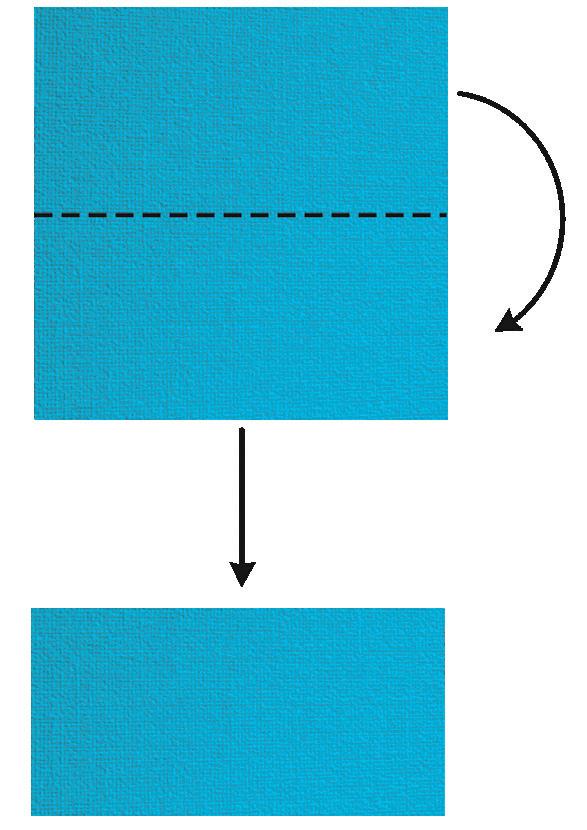
3. Take the second sheet and fold it in such a way that its opposite corners meet each other.


Which shape have you formed?
How many sides does it have?
4. Can you fold the square sheet to form a circle?
YES NO
) A square has four equal sides.
) It can be folded into a rectangle. A rectangle has two opposite equal sides.
) A square can also be folded into a triangle. A triangle has three sides.
) We cannot fold a square into a circle.

For the teacher
Assist the children to do the activity. Demonstrate it in class and let the children observe and do it with you.

In this fun activity, we are going to learn how to form patterns with different colours.
Let’s Collect
) 4 wooden ice-cream sticks

Let’s Do
) Packets of bindi of 2 colours


1. Take one ice-cream stick and paste a bindi of any colour on its one end.

2. Paste a bindi of another colour on it, after the first bindi.


3. Continue to paste the bindis of both the colours one after the other. Do you see a pattern of bindis on your stick?
YES NO
4. Take the other sticks and form different patterns of your choice using bindis of different colours.

) We can form patterns with different colours. Now We Know

For the teacher
Assist the children to do the activity. Demonstrate making different patterns for children to see and follow. This activity can also be done by stringing beads or using blocks of different colours.

In this fun activity, we are going to make block towers and compare their heights.
Let’s Collect
) 6 playing blocks of different sizes

) A length of string to measure height

Let’s Do
1. Take one block of any shape you like and keep it on your desk.

2. Take another block and stack it on top of the first one.

Are you able to stack it easily?
YES NO

3. Keep stacking all the blocks, one on top of the other, in whichever way you like.

4. Take the string. Measure the height of your tower with your teacher’s help. Tie a knot on the string at the place where it touches the top of your tower.

5. Make towers of different heights. Take your teacher’s help to measure and compare their heights.
) We can make a tower of blocks taller or shorter by stacking them in different ways.

For the teacher
Assist the children to do the activity. Demonstrate it in class and let the children observe and do it with you.
In this fun activity, we are going to learn about a full and an empty container.
Let’s Collect
) A small plastic jar, or a bowl, with a lid
) Cotton balls of different colours

Let’s Do
1. Take the plastic container and turn it upside down. Does anything fall from it?
NO Is the container empty or full?
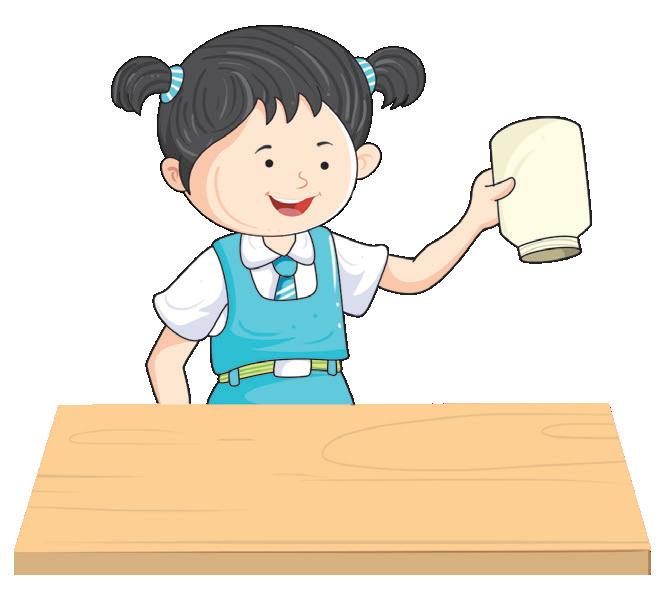

2. One by one, start putting the cotton balls in it till they reach the top.
Is your container empty or full?
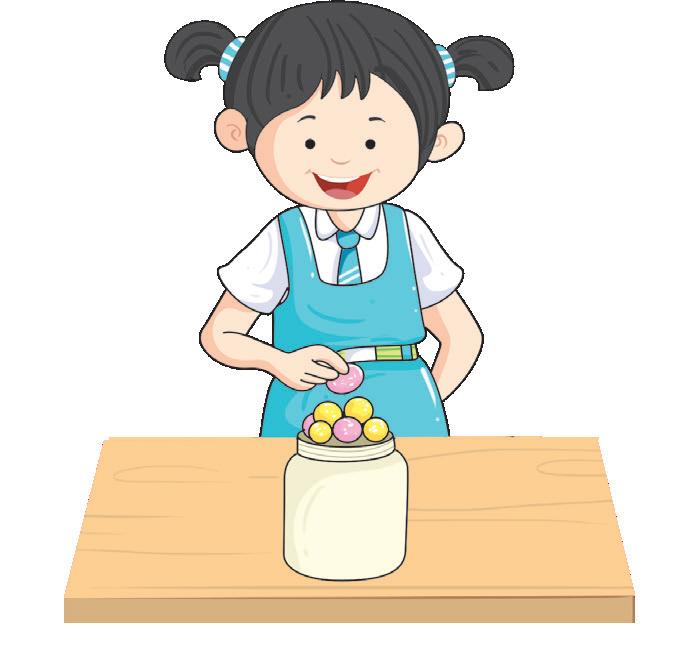

3. Think and tell your teacher what will happen if you turn it upside down. Will the cotton balls fall out of the jar? YES NO
4. Cover the container with the lid.
Turn it upside down now. Do the cotton balls fall from it?
YES NO

) We can turn an empty container upside down.
) We cannot turn a full container upside down without a lid.
) If we turn a full container upside down without covering it, the things in it will fall out from it.

Assist the children to do the activity. Demonstrate it in class and let the children observe and do it with you. Make it more fun by showing them how the cotton balls fall down when the container is turned upside down without being covered with the lid.

In this fun activity, we are going to learn the concept of in and out.
Let’s Collect
) A small bowl
) 20 crayons

Let’s Do
1. Pick up some crayons in one hand and put them in the bowl. How many crayons are in the bowl? How many crayons are outside the bowl?

2. Pick up all the crayons that are outside and put them in the bowl. How many crayons are in the bowl? How many crayons are outside the bowl?


3. Pick up all the crayons from the bowl and keep them outside it. Are there any crayons in the bowl?
YES NO
) Putting things in a container or taking them out of a container makes it half-full, full or empty.

For the teacher
Assist the children to do the activity. Demonstrate it in class and let the children observe and do it with you. Repeat it to strengthen their counting skills.

In this fun activity, we are going to learn how to sort long and short things.
Let’s Collect
) Thin strips of coloured paper, one long and the other short.

) Glue stick




Let’s Do
1. Take two strips of any one colour.
2. Compare their size and paste in the correct columns in the given table.
3. Repeat with all other colours.
) We can compare and sort things of different lengths.

Give strips of different colours and lengths to the children to sort. Make sure the strips are not longer than the size of the boxes of the table. Assist them to do the activity.

In this fun activity, we are going to learn that air can blow things away.
Let’s Collect
) A small tray

Let’s Do
) Small bits of paper

1. Switch off the fan of the room, if it is on.


2. Keep the bits of paper on the tray. Do they blow away? YES NO
3. Move close to the tray and blow hard on the paper strips. Do they blow away now? YES NO


4. Now take some bits of paper in your hands. Do they blow away?
YES NO
) Moving air can blow things away. Now We Know

For the teacher
Assist the children to do the activity. Demonstrate it in class and let the children observe and do it with you.

In this fun activity, we are going to learn about numbers and their order.
Let’s Collect
) 20 wooden ice-cream sticks
) A marker of any colour

Let’s Do
1. Your teacher will write the numbers from 1 to 20 on the ice-cream sticks (one number on each stick).



2. Pick up any one stick and stand in a line with your friends.
Write the number on your stick in this box.
3. Your teacher will call out the numbers, from 1 to 20, in order. Do you have the number 1 on your stick?
YES NO


4. Come forward if you have the number 1 written on your stick.

5. Line up in order, from 1 to 20, as your teacher keeps calling out the numbers one by one.

Now We Know
) We can place jumbled numbers in the correct order by arranging them.

Assist the children to do the activity. You can also introduce the concepts of bigger and smaller numbers, missing numbers, and other concepts using the sticks.
In this fun activity, we are going to learn about animals and the way they move.
Let’s Collect
) Pictures of different animals (4 pictures of each animal card)




Let’s Do
1. Pick up any one picture and hold it in your hand.
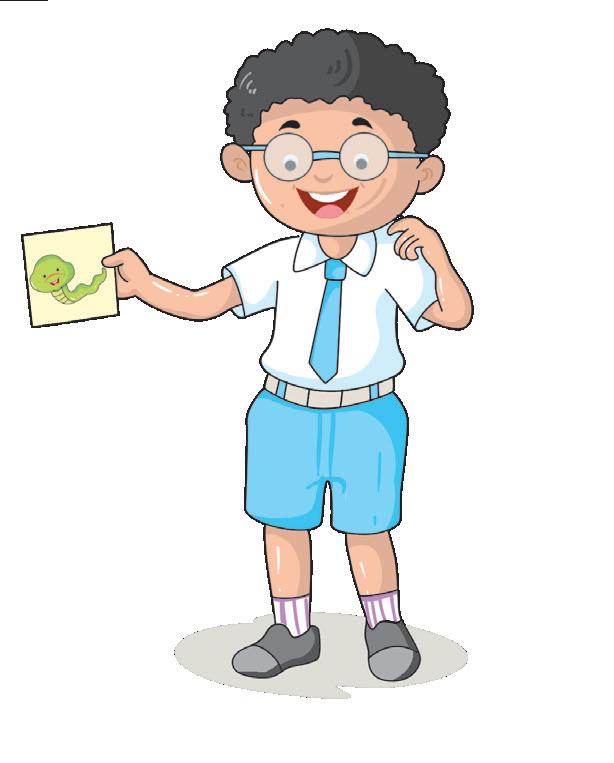

2. Your teacher will loudly say how one animal moves.
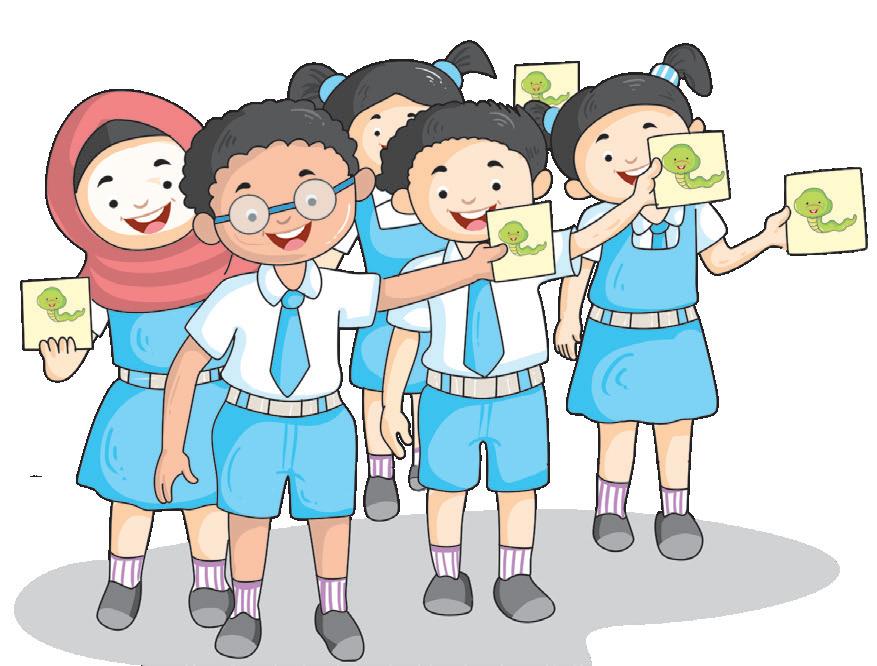

3. Guess which animal it is. Come forward if you are holding that animal’s picture.
4. Three more of your friends will be the same animal. Form a line together.

5. Move like the animal while saying, “I am .”
For example, if you have the picture of a snake, move like it and say, “I am a snake.”

Now We Know
) Animals are different from each other and they move in different ways.

For the teacher
Assist the children to do this fun activity.

In this fun activity, we are going to learn how water changes its form.
Let’s Collect ) Ice-cube tray ) Water ) Ziplock bag
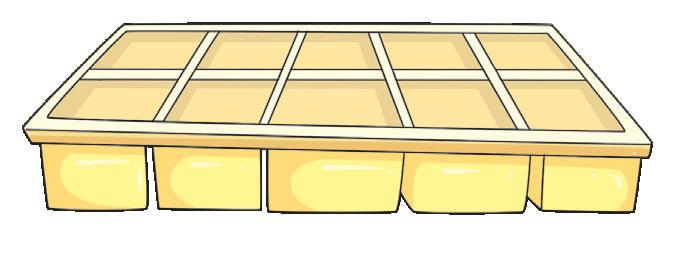
Let’s Do


1. Fill the ice cube tray with water and put it in the freezer.


2. Take out the tray from the freezer after a few hours.

‘A
few hours later’

Does the water become hard and change into ice?
YES NO
3. Take out some ice cubes, put them in the ziplock bag and zip it tightly.


4. Keep the bag near a window where there is sunlight.

Do the ice cubes melt and change back to water?
YES NO
) Water has different forms. It changes to ice when we freeze it. The ice changes back to water when we keep it outside the freezer.

For the teacher
Assist the children to do the activity. It can be done in groups or you can show it in class and let the children observe and talk about it.
In this fun activity, we are going to learn how some things sink while some float when they are put in water.
Let’s Collect
) A small stone
) A pencil
) A crayon
) An empty plastic bottle
) An iron nail
) A small blown balloon filled with air
) A small tub of water
Let’s Do
1. Fill half of the tub with water.




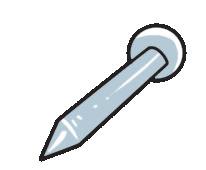




2. Add the things in it, one by one.

3. Observe and colour the box ‘Float’ if the thing floats, and ‘Sink’ if the thing sinks, in the given table.
Thing Float
stone pencil crayon plastic bottle nail balloon
) Things that are heavy sink in water. Things that are light float on water.

For the teacher
Assist the children to do the activity. You can also show it in class and let the children observe and fill their tables.
Do this fun activity to separate the heavy things from the light ones.
Let’s Collect
) Two empty cups
) Some small stones
) Some cotton balls

Let’s Do
1. Take one empty cup. Put the stones in it. Is the cup with the stones lighter than the empty cup?
YES NO


2. Fill the second cup with the cotton balls.
Is the cup with the stones heavier than the cup with the cotton balls?
YES NO
This shows stones are heavier than cotton balls.
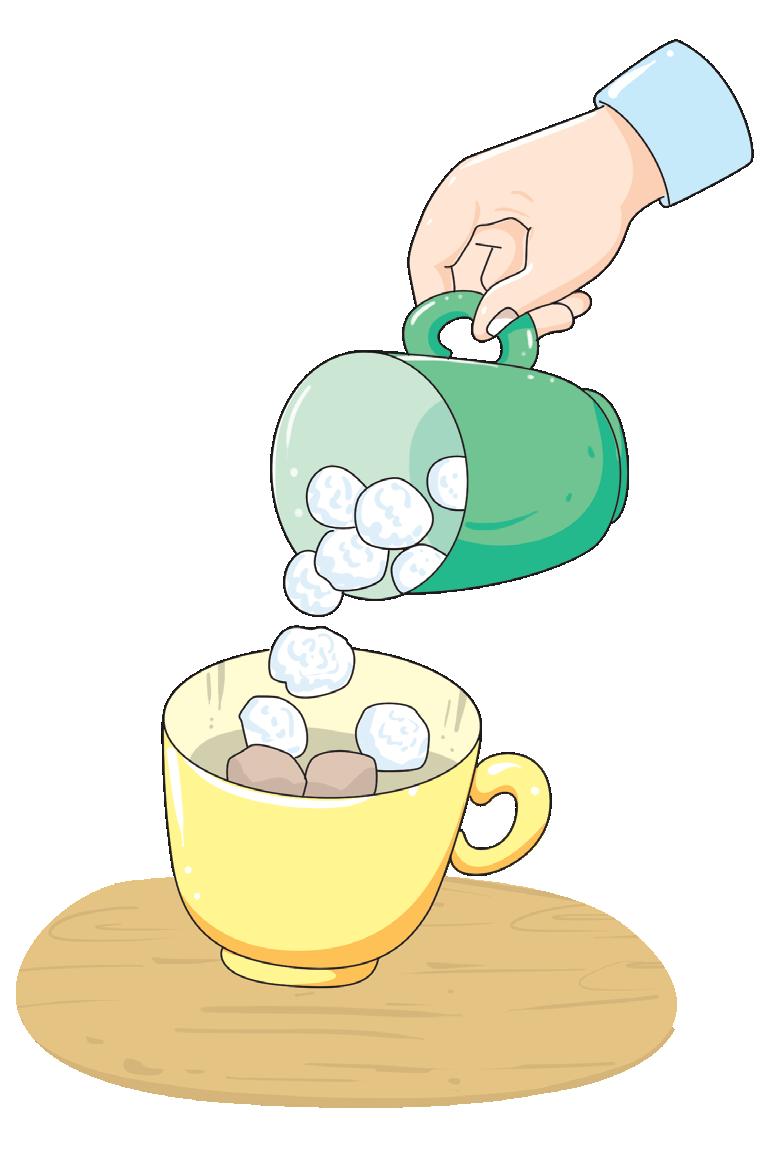

3. Now, mix up the stones and the cotton balls.
4. Sort the things inside the cup by separating the heavy from the light.

) All things do not have the same weight. Some are heavy and some are light.

Give a chance to each child individually to do this activity and answer the questions.

DAWN is a comprehensive, NCF 2022-based Early Childhood Education program that lays a solid foundation for lifelong well-being and holistic growth, encompassing physical, cognitive, and socio-emotional development.
The book exposes students to basic concepts of STEM through simple, hands-on experiments on topics of space, temperature, dimensions, and sequence.
Additional Resources
• Flash Cards
• Sticker Sheets
• Suggested Activities List, for teacher and parents
• Teacher's Manual
• Digital Resouces
• Assessment Sheets and Holistic Progress Card
• Play-based learning activities, which promote holistic development of the child in all ECE domains
• School readiness, which is assured in the curriculum and learning design
• All-round development, in areas of physical, cognitive, cultural and socio-emotional domains
• Teacher assets, like assessment tools and lesson plans to help maximise program quality and outcomes
Uolo partners with K-12 schools to provide technology-enabled learning programs. We believe that pedagogy and technology must come together to deliver scalable learning experiences that generate measurable outcomes. Uolo is trusted by over 15,000+ schools across India, Southeast Asia and the Middle East.
ISBN 978-81-980546-6-1

hello@uolo.com
Not to be sold separately